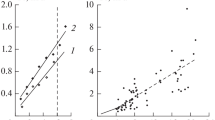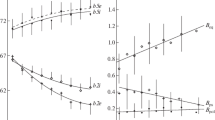Abstract
A planetary pattern of substorm development in auroral precipitation has been constructed on the basis of the F6 and F7 satellite observations. The behavior of the auroral injection boundaries and characteristics of precipitating electrons in various precipitation regions during all phases of a statistically mean magnetospheric substorm with an intensity of AL ∼ −400 nT at a maximum is considered in detail. It is shown that during a substorm, the zone of structured auroral oval precipitation AOP and the diffuse auroral zone DAZ are the widest in the nighttime and daytime sectors, respectively. In the daytime sector, all precipitation regions synchronously shift equatorward not only at the origination phase but during the substorm development phase. The strongest shift to low latitudes of the daytime AOP region is observed at a maximum of the development phase. As a result of this shift, the area of the polar cap increases during the phases of substorm origination and development. It is shown that the average position of the precipitation boundaries and the energy fluxes of precipitating electrons at each phase are linearly related to the intensity of a magnetic disturbance. This makes it possible to develop a model of auroral precipitation development during each phase of substorms of any intensity.
Similar content being viewed by others
References
S.-I. Akasofu, “Midday Auror as at the South Pole during Magnetospheric Substroms,” J. Geophys. Res. 77, 2303–2309 (1972).
S.-I. Akasofu, “The Development of Auroral Substorm,” Planet. Space Sci. 19, 273–284 (1964).
S.-I. Akasofu, C.-I. Meng, and D. S. Kimball, “Dynamics of Aurora. 4. Polar Magnetic Substorm and Westward Traveling Surge,” J. Atmos. Terr. Phys. 28, 489–496 (1966).
S.-I. Akasofu, C.-I. Meng, and K. Makita, “Changes of the Size of Open Field Line Region during Substorm,” Planet. Space Sci. 40, 1513–1524 (1992).
S.-I. Akasofu, M. Roederer, G. K. Corrik, and D. N. Covey, “Equatorward Shift of the Cusp during Magnetospheric Substorm,” Planet. Space Sci. 29, 317–320 (1981).
S.-I. Akasofu, Physics of Magnetospheric Substorms (Reidel, Dordrecht, 1977).
M. Brittnacher, M. Fillingim, G. Parks, et al., “Polar Cap Area and Boundary Motion during Substorms,” J. Geophys. Res. 104, 12 251–12 262 (1999).
J. L. Burch, “Rate of Erosion of Dayside Magnetic Flux Based on a Quantitative Study of the Dependence of Polar Cusp Latitude on the Interplanetary Magnetic Field,” Radio Sci. 8, 955–961 (1973).
J. F. Carbary, T. Sotirelis, P. T. Newell, and C.-I. Meng, “Correlation of LBH Intensities with Precipitating Particle Energies,” Geophys. Res. Lett. 31, L13801 (2004).
S. A. Chernous, V. G. Vorobjev, V. R. Tagirov, et al., “Television and Photometric Observations of the Transition Region between Discrete Arcs and Pulsations in Dayside Auroras,” in Proceedings of the International Symposium on Polar Geomagnetic Disturbances and Related Phenomena “Polar Geomagnetic Phenomena of May 25–31, 1986, Suzdal’,” SSSR, 1989, pp. 46–50.
N. P. Dmitrieva and V. A. Sergeev, “Spontaneous and Forced Onset of the Magnetospheric Substorm Expansion Phase and the Duration of the Substorm Preliminary Phase,” Geomagn. Aeron. 23(3), 470–474 (1983).
R. H. Eather, “Polar Cusp Dynamics,” J. Geophys. Res. 90, 1569–1576 (1985).
R. H. Eather, S. B. Mende, and E. J. Weber, “Dayside Aurora and Relevance to Substorm Current System and Dayside Merging,” J. Geophys. Res. 84, 3339–3359 (1979).
Ya. I. Feldstein and Yu. I. Galperin, “Auroral Precipitation Structure in the Nightside Sector of the Magnetosphere,” Kosm. Issled. 34, 227–247 (1996).
Ya. I. Feldstein and G. V. Starkov, “Dynamic of the Auroral Belt and Polar Geomagnetic Disturbances,” Planet. Space Sci. 15, 209–229 (1967).
Ya. I. Feldstein and Yu. I. Galperin, “An Alternative Interpretation of Auroral Precipitation and Luminosity Observations from the DE, DMSP, Aurora and Viking Satellites in Terms of Their Mapping to the Nightside Magnetosphere,” J. Atmos. Terr. Phys. 55, 105–121 (1993).
L. A. Frank and J. D. Craven, “Imaging Results from Dynamic Explorer 1,” Rev. Geophys. 26, 249–283 (1988).
Yu. I. Galperin and Ya. I. Feldstein, “Auroral Luminosity and Its Relationship to Magnetospheric Plasma Domains,” in Auroral Physics, Ed. by C.-I. Meng (UP, Cambridge, 1991), pp. 207–222.
G. F. Germany, G. K. Parks, M. Brittnacher, et al., “Remote Determination of Auroral Energy Characteristics during Substorm Activity,” Geophys. Res. Lett. 24, 995–998 (1997).
D. A. Hardy, M. S. Gussenhoven, and D. Brautingam, “A Statistical Model of Auroral Electron Precipitation,” J. Geophys. Res. 90, 4229–4248 (1985).
T. Iijima and T. Nagata, “Signatures for the Substorm Development of the Growth Phase and Expansion Phase,” Planet. Space Sci. 20, 1095–1101 (1972).
D. Ya. Ivliev, M. I. Pudovkin, and S. A. Zaitseva, “Development of Elementary Magnetic Disturbance,” Geomagn. Aeron. 10(2), 300–304 (1970).
Y. Kamide, J. L. Burch, J. D. Winingham, and S.-I. Akasofu, “Dependence of the Latitude of the Cleft on the Interplanetary Magnetic Field and Substorm Activity,” J. Geophys. Res. 81, 698–704 (1976).
K. Kauristie, “Statistical Fits for Auroral Oval Boundaries during the Substorm Sequence,” J. Geophys. Res. 100, 21 885–21 895 (1995).
S. Kokubun, “Polar Substorm and Interplanetary Magnetic Field,” Planet. Space Sci. 18, 697–705 (1970).
S. Kokubun, R. L. McPherron, and C. T. Russell, “Triggering of Substroms by Solar Wind Discontnuities,” J. Geophys. Res. 82, 74–86 (1977).
L. R. Lyons, “Substorms: Fundamental Observational Features, Distinction from Other Disturbances, and External Triggering,” J. Geophys. Res. 101, 13011–13026 (1996).
K. Makita, C.-I. Meng, and S.-I. Akasofu, “Temporal and Spatial Variations of the Polar Cap Dimension Inferred from Precipitation Boundaries,” J. Geophys. Res. 90, 2744–2752 (1985).
Yu. P. Maltsev, “Search of Relation between the Substorm Onset and the Solar Wind Parameters,” in Proceedings of the International Conference on Substorm-4, Nagoya, 1998, pp. 291–294.
I. B. McDiarmid, J. R. Burrows, and E. E. Budsinski, “Average Characteristics of Magnetospheric Electrons (159 eV to 200 KeV) at 1400 km,” J. Geophys. Res. 80, 73–79 (1975).
R. L. McPherron, “Growth Phase of Magnetospheric Substroms,” J. Geophys. Res. 75(28), 5592–5599 (1970).
C.-I. Meng and K. Makita, “Dynamic Variations of the Polar Cap,” in Solar Wind-Magnetosphere Coupling, Ed. by Y. Kamide and J. A. Slavin (Sci. Terra, Tokyo, 1986), pp. 605–631.
C.-I. Meng, “Dynamic Variations of the Auroral Oval during Intense Magnetic Substroms,” J. Geophys. Res. 89, 227–235 (1984).
S. E. Milan, M. Lester, S. W. H. Cowley, et al., “Variations in the Polar Cap Area during Two Substorm Cycles,” Ann. Geophys. 21, 1121–1140 (2003).
P. T. Newell and C.-I. Meng, “Ionospheric Projections of Magnetospheric Regions under Low and High Solar Pressure Conditions,” J. Geophys. Res. 99, 273–286 (1994).
P. T. Newell and C.-I. Meng, “Mapping the Dayside Ionosphere to the Magnetosphere according to Particle Precipitation Characteristic,” Geophys. Res. Lett. 19, 609–612 (1992).
P. T. Newell, K. Liou, T. Sotirelis, and C.-I. Meng, “Polar Ultraviolet Imager Observations of Global Auroral Power as a Function of Polar Cap Size and Magnetotail Stretching,” J. Geophys. Res. 106, 5895–5906 (2001).
P. T. Newell, S. Wing, C.-I. Meng, and V. Sigillito, “The Auroral Oval Position, Structure and Intensity of Precipitation from 1984 onward: An Automated On-Line Data Base,” J. Geophys. Res. 96, 5877–5882 (1991).
P. T. Newell, V. A. Sergeev, G. R. Bikkuzina, and S. Wing, “Characterizing the State of Magnetosphere: Testing the Ion Precipitation Maxima Latitude (b2i) and the Ion Isotropy Boundary,” J. Geophys. Res. 103, 4739–4746 (1998).
P. T. Newell, Y. I. Feldstein, Yu. I. Galperin, and C.-I. Meng, “Morphology of Nightside Precipitation,” J. Geophys. Res. 101, 10 737–10 748 (1996).
L. M. Nikolaenko, Yu. I. Galperin, Ya. I. Feldstein, et al., “Diffuse Zone: VII. The Dynamics of the Equatorward Boundary of the Electron Diffuse Precipitation Zone in the Dusk Sector,” Kosm. Issled. 21, 876–884 (1983).
J. C. Samson, L. R. Lyons, B. Xu, et al., “Proton Aurora and Substorm Intensifications,” J. Geophys. Res. 19, 2167–2170 (1992).
P. E. Sandholt, A. Egeland, C. S. Deehr, et al., “Effect of Interplanetary Magnetic Field and Magnetospheric Substorm Variations on the Dayside Aurora,” Planet. Space Sci. 31, 1345–1362 (1983).
P. E. Sandholt, C. S. Deehr, A. Egeland, et al., “Signatures in the Dayside Aurora of Plasma Transfer from the Magnetosheath,” J. Geophys. Res. 91, 10063–10079 (1986).
V. A. Sergeev and B. D. Gvozdevsky, “MT-Index—A Possible New Index to Characterize the Magnetic Configuration of Magnetotail,” Ann. Geophys. 13, 1093–1103 (1995).
T. Sotirelis and P. T. Newell, “Boundary Oriented Electron Precipitation Model,” J. Geophys. Res. 105, 18655–18673 (2000).
R. W. Spiro, P. H. Reiff, and L. J. Mahler, “Precipitating Electron Energy Flux and Auroral Zone Conductances—An Empirical Model,” J. Geophys. Res. 87, 8215–8227 (1982).
G. V. Starkov and Ya. I. Feldstein, “A Change in the Auroral Oval Zone Boundaries,” Geomagn. Aeron. 7, 62–71 (1967).
G. V. Starkov and Ya. I. Feldstein, “Substorm in Auroras,” Geomagn. Aeron. 11(3), 560–562 (1971).
G. V. Starkov, B. V. Rezhenov, V. G. Vorobjev, and Ya. I. Feldstein, “Planetary Distribution of Auroral Precipitation and Its Relation to the Zones of Auroral Luminosity,” Geomagn. Aeron. 43(5), 609–619 (2003) [Geomagn. Aeron. 43, 569–578 (2003)]
G. V. Starkov, Ya. I. Feldstein, and N. F. Shevnina, “Dayside Oval Precipitation during Substroms,” Geomagn. Aeron. 13, 86–90 (1973).
M. R. Torr, D. J. Torr, M. Zukic, et al., “Far Ultraviolet Imager for the International Solar-Terrestrial Physics Mission,” Space Sci. Rev. 71, 329–383 (1995).
O. A. Troshichev, A. L. Kotikov, B. D. Bolotinskaya, and V. G. Andrezen, “Influence of the IMF Azimuthal Component on the Magnetospheric Substorm Dynamics,” J. Geomagn. Geoelectr. 38, 1075–1088 (1986).
V. G. Vorobjev and O. I. Yagodkina, “Effect of Magnetic Activity on the Global Distribution of Auroral Precipitation Zones,” Geomagn. Aeron. 45(4), 467–473 (2005) [Geomagn. Aeron. 45, 438–444 (2005)].
V. G. Vorobjev, V. L. Zverev, G. V. Starkov, and Ya. I. Feldstein, “The Dynamics of Dayside Auroras Depending on IMF and Magnetic Activity,” Geomagn. Aeron. 28(2), 251–255 (1988).
V. G. Vorobjev, G. Gustafsson, G. V. Starkov, et al., “Dynamics of Day and Night Aurora during Substorm,” Planet. Space Sci. 23, 269–278 (1975).
V. G. Vorobjev, G. V. Starkov, and Ya. I. Feldstein, “The Auroral Oval during the Substorm Development,” Planet. Space Sci. 24, 955–965 (1976).
V. G. Vorobjev, O. I. Yagodkina, G. V. Starkov, and Ya. I. Feldstein, “A Substorm in Midnight Auroral Precipitation,” Ann. Geophys. 21, 2271–2280 (2003).
O. I. Yagodkina, V. G. Vorobjev, and S. V. Leontiev, “Pulsating Aurora and Geomagnetic Pulsations in Daytime High-Latitude Region,” Planet. Space Sci. 38, 149–159 (1990).
Author information
Authors and Affiliations
Additional information
Original Russian Text © V.G. Vorobjev, O.I. Yagodkina, G.V. Starkov, Ya.I. Feldstein, 2007, published in Geomagnetizm i Aeronomiya, 2007, Vol. 47, No. 2, pp. 206–218.
Rights and permissions
About this article
Cite this article
Vorobjev, V.G., Yagodkina, O.I., Starkov, G.V. et al. Features of the planetary distribution of auroral precipitation characteristics during substorms. Geomagn. Aeron. 47, 193–204 (2007). https://doi.org/10.1134/S0016793207020077
Received:
Issue Date:
DOI: https://doi.org/10.1134/S0016793207020077




